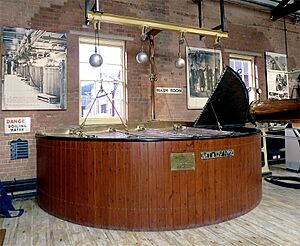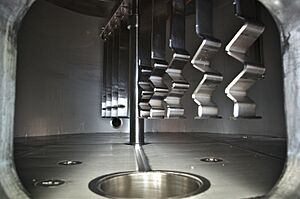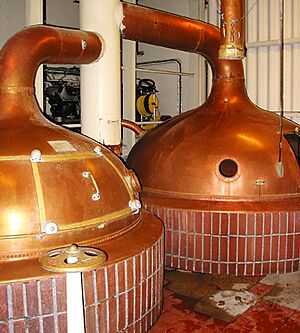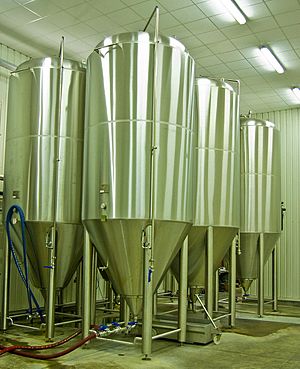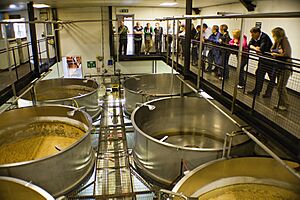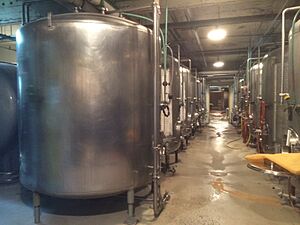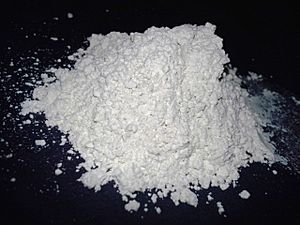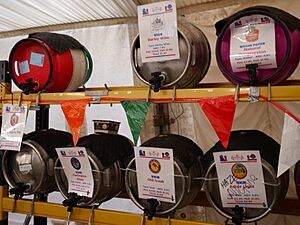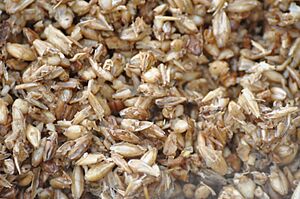Brewing facts for kids
Brewing is the process of making beer. It's like a special kind of cooking that uses tiny living things called yeast to turn simple ingredients into a drink. This usually happens in a place called a brewery, but some people also make it at home.
Contents
What is Brewing?
Brewing is the art and science of making beer. It involves several steps that change basic ingredients like grain, water, hops, and yeast into the final product. The main part of brewing is called fermentation. This is when yeast eats the sugars from the grains and turns them into alcohol and carbon dioxide gas.
A Journey Through Time: The History of Brewing
People have been brewing for thousands of years! It's one of the oldest human activities.
When Did Brewing Start?
Evidence shows that brewing began way back in ancient times. Some of the earliest signs come from Mesopotamia (modern-day Iraq) and ancient Egypt. People in these civilizations made beer from grains like barley and wheat. They even had special recipes and brewers. For example, the Alulu beer receipt from around 2050 BC records a purchase of beer.
Brewing Through the Ages
Over time, brewing spread around the world. In the Middle Ages, monasteries in Europe often brewed beer. It was a safer drink than water in many places because the brewing process killed harmful germs. Later, brewing became a big industry, with larger breweries making beer for many people.
The Main Ingredients
Four main ingredients are used to brew beer:
- Water: This is the biggest ingredient, making up most of the beer. The type of water can affect the taste.
- Malt: This usually comes from barley grains that have been specially prepared. The grains are soaked in water, allowed to sprout a little, and then dried. This process, called malting, creates sugars that the yeast will later eat.
- Hops: These are flowers from the hop plant. They add bitterness to balance the sweetness of the malt. Hops also give beer its aroma and help keep it fresh.
- Yeast: These are tiny, single-celled fungi. They are the true workers of brewing! Yeast eats the sugars in the malt and produces alcohol and carbon dioxide gas during fermentation.
How Beer is Made: The Brewing Steps
Brewing involves several important steps that must be followed carefully.
Milling and Mashing
First, the malted grains are crushed. This is called milling. Crushing helps to break open the grain kernels. Next, the crushed grains are mixed with hot water in a large tank called a mash tun. This step is called mashing. The hot water helps to activate natural enzymes in the malt. These enzymes break down the starches in the grains into simpler sugars. This sugary liquid is called wort.
Lautering
After mashing, the sugary wort needs to be separated from the spent grain. This is done in a process called lautering. The wort is drained from the mash tun, leaving the solid grain behind. The grains are often rinsed with more hot water to get out any remaining sugars.
Boiling and Hopping
The wort is then transferred to a large kettle and boiled. This boiling step is very important. It sterilizes the wort, killing any unwanted bacteria. It also helps to concentrate the sugars. During the boil, hops are added. Hops give beer its unique bitter taste and aroma. They also help to preserve the beer. The length of the boil and when the hops are added can greatly affect the final flavor.
Fermentation
After boiling, the hot wort is cooled down quickly. Once it's cool enough, yeast is added. This is when fermentation begins! The wort is moved into special fermentation vessels. The yeast starts to eat the sugars in the wort. As the yeast works, it produces alcohol and carbon dioxide gas. This process can take several days or even weeks.
Conditioning and Filtering
Once fermentation is complete, the beer is often moved to another tank for conditioning or maturation. During this time, the beer develops its final flavors and aromas. Any remaining yeast or particles settle out. Some beers are then filtered to make them clear and bright. Filtration removes any leftover yeast or haze. Other beers are left unfiltered, which means they might look a bit cloudy.
Packaging
Finally, the finished beer is ready to be packaged. It can be put into bottles, cans, or kegs. Before packaging, some brewers might add a little more sugar and yeast to the beer. This allows for a small amount of fermentation to happen in the bottle or keg, creating natural carbonation (the bubbles!).
What Happens to Leftovers?
After brewing, there are often leftover materials. The most common leftover is spent grain. This is the grain that remains after the sugars have been extracted. Spent grain is often used as animal feed because it's still full of nutrients. It can also be used in baking or composting.
Images for kids
See also
 In Spanish: Elaboración de cerveza para niños
In Spanish: Elaboración de cerveza para niños


